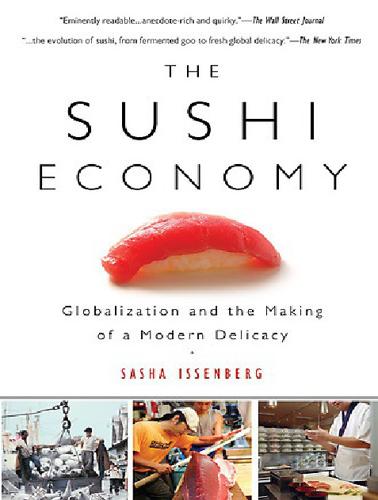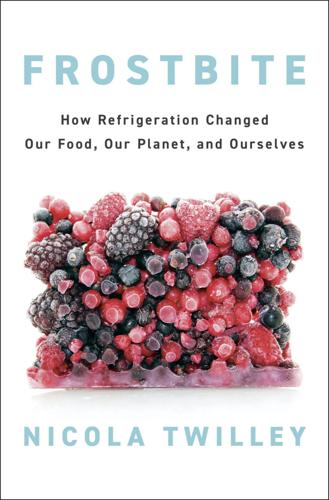Akira Okazaki
description: Japanese scientist, contributions to molecular biology
4 results

The Sushi Economy: Globalization and the Making of a Modern Delicacy
by
Sasha Issenberg
Published 1 Jan 2007
MacAlpine included an additional piece of information as something of an afterthought. “What they did after they caught them is they had their picture taken with the fish and dug a hole with a small bulldozer and buried them,” MacAlpine reported back. It was long after MacAlpine’s reponse arrived in Tokyo that Akira Okazaki decided to make his way to Canada. Akira Okazaki was born in prewar Japan and spent his pre teen years in Shanghai with a father sent there to represent the Bank of Japan during that country’s imperial occupation of northern China. Kaheita Okazaki had been trained as a lawyer, but he found utopian potential in business; high-school friendships with Chinese students in Japan convinced him that commercial ties between nations could “create peace within Asia.”
…
At the time, JAL did not even have flights out of Toronto, but MacAlpine’s assignment was to discover untapped exporters in eastern Canada whose products could be transferred onto Tokyo-bound JAL flights from Vancouver and Los Angeles. His target list included products such as business equipment, chemicals, aircraft parts—nonperishable goods that the industry calls “hard cargo”—that would find willing buyers in booming Japan. The Teletype arrived in late summer from JAL’s headquarters in Tokyo. It was written by Akira Okazaki, whom MacAlpine had never met but knew was the man responsible for uncovering new markets for cargo worldwide. The message had a simple request: What could MacAlpine find out about tunafishing along Canada’s eastern coast? The inquiry confused MacAlpine, who had entered the air-freight business thinking that the one-way problem would be sorted out in a factory, not on a pier.
…
Kaheita Okazaki had been trained as a lawyer, but he found utopian potential in business; high-school friendships with Chinese students in Japan convinced him that commercial ties between nations could “create peace within Asia.” Once, after learning that his son had sprayed a Chinese boy with a water pistol, Kaheita dragged young Akira across Shanghai so he could apologize—in the formal Japanese style of kneeling on the ground—to his damp victim. In his twenties, Akira Okazaki went to work for Japan Airlines, a company born amid Japan’s postwar recovery and initially so modest that in its first offices, in Ginza, executives sat on tatami mats. But its international expansion was swift: Two years later, JAL opened offices in New York and Honolulu and, in 1954, inaugurated its first international flights, to San Francisco.

Aerotropolis
by
John D. Kasarda
and
Greg Lindsay
Published 2 Jan 2009
Fifty years ago, sushi was a snack of rice balls pickled in soy sauce and vinegar, while the silvery-skinned fish was so worthless Canadian fishermen regularly dumped their catches in a hole and bulldozed them. Sushi’s elevation to a paragon of freshness and yuppie emblem—headlined by the fatty toro carved from the bluefin’s belly—can be traced to a Japanese Airlines executive named Akira Okazaki. Okazaki worked in the airline’s cargo division in the early 1970s, when his job was to fill the empty bellies of JAL’s 747s on their return legs to Tokyo. The home islands were already overfished by then, and pollution was taking a toll on the seabed. Okazaki hit upon the idea of adapting the cool chain to tuna, converting a nuisance in Nova Scotia into a delicacy in Osaka.
…
Additional details on Kenyan rose farms and the loss of business to Ethiopia were found in “Roses Are Red” (The Economist, February 9, 2008). The path my tulips took through the auctions was explained in an e-mail from Hilverda De Boer’s Chicago representative Susan Tock. And plans for the futuristic Aalsmeer appeared in From Green to Gold. Japan Airlines sent me Akira Okazaki’s final report on the events leading up to “the day of the flying fish,” which also appears in Sasha Issenberg’s The Sushi Economy. Tom Asakawa of NOAA’s Fisheries Service was kind enough to lead me on a tour of Tsukiji. Dane Klinger and Kimiko Narita explained why the Atlantic bluefin tuna is likely doomed in their article “Peak Tuna” (ForeignPolicy.com, February 12, 2010).

Frostbite: How Refrigeration Changed Our Food, Our Planet, and Ourselves
by
Nicola Twilley
Published 24 Jun 2024
As Sasha Issenberg recounts in The Sushi Economy, two simultaneous innovations that took place in 1970—“the ability to make tuna available to diners across long distances, and a newly acquired taste for fat among sushi’s greatest enthusiasts”—combined to transform bluefin tuna from a worthless trash fish into one the world’s most expensive foods. The man responsible for the first breakthrough was a young Japan Airlines executive, Akira Okazaki, charged with solving the company’s unique freight problem. At the time, Japan was at the height of its postwar “economic miracle,” with a reputation for manufacturing and exporting high-quality semiconductors, cameras, audio equipment, game consoles, and medical devices. While Japan’s trade surplus increased year on year through the 1970s, the US trade deficit was on track to become the world’s largest.

Bourgeois Dignity: Why Economics Can't Explain the Modern World
by
Deirdre N. McCloskey
Published 15 Nov 2011
You could also call it, and Klamer does, the “conversation” of the culture. In other words, the Third Sphere depends (as the other spheres also do) on Klamer’s master concept, the conversation—the conversation about being an American woman or a Dutch merchant or a person who values modern art or an executive developing trust in a business relationship. Akira Okazaki of Japan Airlines played cards for months with fisherman from Prince Edward Island in Canada during the 1970s in order to develop a backhaul business in bluefin-tuna-on-ice for the sushi market back home.4 Talk, talk, talk. Realize social values. Okazaki made friends. And did a little business on the side.